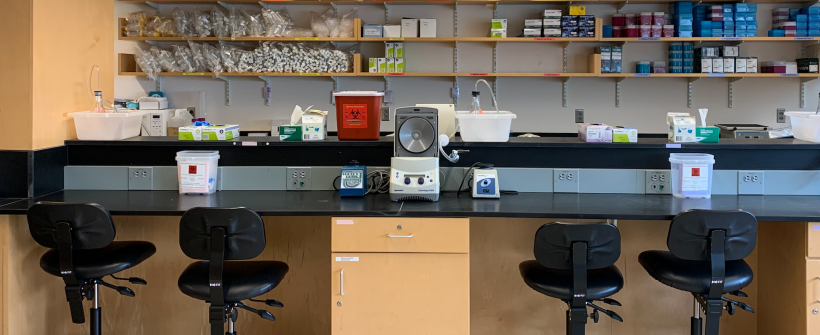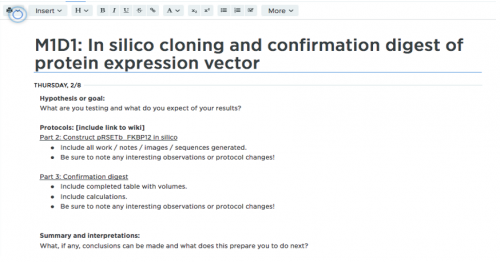Difference between revisions of "20.109(F20):Homework"
From Course Wiki
Noreen Lyell (Talk | contribs) (→Module 1: Genomic instability) |
Noreen Lyell (Talk | contribs) (→Due M1D2) |
||
| Line 26: | Line 26: | ||
#*Name the collection appropriate (e.g. 20.109 Notebook Templates) | #*Name the collection appropriate (e.g. 20.109 Notebook Templates) | ||
#*Create a new template within the newly created collection by typing in the name (e.g. Lab Notebook Entry Template) and press "Create Template." | #*Create a new template within the newly created collection by typing in the name (e.g. Lab Notebook Entry Template) and press "Create Template." | ||
| − | #*Type in the categories or whatever reminders will help you fill out your lab notebook entry appropriately | + | #*Type in the categories or whatever reminders will help you fill out your lab notebook entry appropriately. It would be wise to base this on the Laboratory notebook guidelines provided as this will ensure the Instructors are able to find the information for grading purposes. |
#*Press "Update Information" to save your edits. | #*Press "Update Information" to save your edits. | ||
#*Now when you want to make a new entry for each lab day, you can make a new entry from this template (When you press the '+' symbol on the top menu bar near your project title, it will give you the option to create an entry from template). | #*Now when you want to make a new entry for each lab day, you can make a new entry from this template (When you press the '+' symbol on the top menu bar near your project title, it will give you the option to create an entry from template). | ||
| − | #Use the Benchling template created above, to generate a page for [[20.109( | + | #Use the Benchling template created above, to generate a page for [[20.109(F20):M1D2 | M1D2]]. |
| − | # | + | #See the example entry below for further guidance. |
| + | [[Image:Fa20 notebook entry template.png|center|500px|thumb]] | ||
Revision as of 17:36, 23 July 2020
Module 1: Genomic instability
Due M1D1
- Review the Orientation and laboratory tour exercises to prepare for the Orientation quiz that you and your partner will complete together during at the start of the laboratory session.
- Though you will not be completing experiments in the laboratory this semester, please complete the following online training offered through Environmental Health and Safety (EHS). First, it is important that you learn best practices this semester and safety is a major part of this. Second, the training certifications do not expire and will be valid when are able to return to campus for UROP work!
- Emergency Preparedness (access at this this link)
- General Chemical Hygiene (access at this link)
- General Biosafety (access at this link)
- If you have completed EHS training in a UROP or in another laboratory class, you do not need to repeat the training. Instead submit the certificates of completion or your training record which can be found at "My Training Needs" on Atlas. To access, go to atlas.mit.edu then click the Learning Center tab on the left side of the screen.
- Download Benchling onto your computer. You will use this program to maintain your laboratory notebook for the semester.
- Prepare for the first day of Module 1 by reading the M1 Project overview and the M1D1 Introduction.
Due M1D2
- Read through the webinair Keeping a Lab Notebook: Basic Principles and Best Practices provided by the National Institutes of Health. Though not all of the specifications will be adhered to in 20.109, please note the information on slide #9 as this is the basis of the rubric developed to grade your notebook entries this semester.
- To prepare for your laboratory session, complete a template for your notebook entry according to the Laboratory notebook guidelines provided on the Assignment tab. You will use these guidelines for every notebook entry you complete in 20.109.
- Click on the '+' symbol on the left menu bar
- Click on More-->Template
- In the "Create Template" dialog box, click "Manage Collections" in the lower left corner.
- Click on "+ New Collection."
- Name the collection appropriate (e.g. 20.109 Notebook Templates)
- Create a new template within the newly created collection by typing in the name (e.g. Lab Notebook Entry Template) and press "Create Template."
- Type in the categories or whatever reminders will help you fill out your lab notebook entry appropriately. It would be wise to base this on the Laboratory notebook guidelines provided as this will ensure the Instructors are able to find the information for grading purposes.
- Press "Update Information" to save your edits.
- Now when you want to make a new entry for each lab day, you can make a new entry from this template (When you press the '+' symbol on the top menu bar near your project title, it will give you the option to create an entry from template).
- Use the Benchling template created above, to generate a page for M1D2.
- See the example entry below for further guidance.

